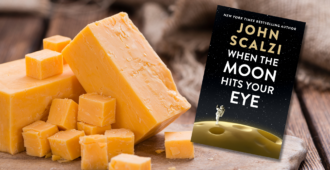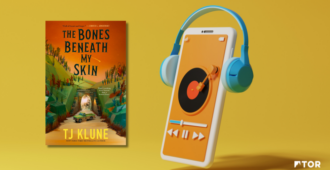Written by Daryl Gregory
Hey, kids! Now you can build a drug factory in your own home!
Or soon, anyway. I believe we’re teetering on the edge of a new era in designer drugs. There are several technologies in play that could converge to democratize drug design and manufacture in the same way that Macs and inkjet printers democratized the production of art—and created thousands of really bad newsletters.
In Afterparty I made up a machine called the chemjet. Like all the tech in the book, from the smart pens everyone uses to the drug-monitoring smart chip implanted in the protagonist’s arm, the chemjet is possible in principle, and most of its required parts exist now.
In form and function, the chemjet’s similar to an inkjet printer. You first load it with chemical precursor packs instead of ink cartridges. Then you download a drug recipe from the internet, or modify an existing one. Fill the input tray with rice paper, and you’re printing your own drugs in no time.
Fleshing out the idea didn’t require much extrapolation. Certainly the idea of home-based drug production isn’t new. The guy with the grow-lights in his basement, or the idiot in the unventilated trailer trying to break bad, are just further along the DIY spectrum from the folks who brew their own beer and roast their own coffee.
The hardware wasn’t much of a reach, either. 3D printers have already demonstrated that desktop manufacturing can be affordable once someone starts building the printers in volume. True, the internals of the machine would have to be much more complex than your usual Easy Bake Oven. In the novel I describe a few key parts—heating elements, distillation chambers, centrifuges, filtration tubes—but keep the exact design vague. (I’m a writer, Jim, not an engineer.)
The drug recipes would be easier to come by than the hardware. Pharmaceutical companies are already using CADD—computer-aided drug design—to construct novel molecules that are shaped to bind to their targets. Drug modeling is a computationally intensive task, but we all know that Moore’s Law makes quick work of supposedly hard problems. The open source hacking culture would provide plenty of novelty.
The biggest obstacle to building our chemjet is the getting packs of the right precursor chemicals. In the novel, the most common precursor chemical is that workhouse of the hallucinogenic and amphetamine industry, phenethylamine. It’s found in human liquids and tissues, and unmodified, it has no effect on man. But add a methyl group to a carbon atom in phenethylamine and you get amphetamine. Add another methyl group to that and you get methamphetamine. A few more twists and you get MDMA—ecstasy. Drop a carbon atom and you get into analgesics and anesthetics.
In writing Afterparty I had a good time inventing new designer drugs, like the synesthesia drug Paint Ball and the pattern-recognition enhancer Clarity. I also showed how rampant experimentation, and the inevitable overdoses, would probably lead to not only death but new types of insanity.
The drug I concentrate on is Numinous, which gives users the feeling of being in direct contact with a higher power. But overdose and you might be wake up with a deity permanently installed in your brain—your own personal Jesus.
Designer drugs like these are in our future, and I wouldn’t be surprised if something like a chemjet isn’t being put together in somebody’s garage right now. After all, near-future science fiction is just the present with the sell-by date scraped off.
…………………………
From the Tor/Forge April 21st newsletter. Sign up to receive our newsletter via email.
…………………………
More from the April 21st Tor/Forge newsletter:
- The Magic of Theater by Melanie Rawn
- Oxted: Building Families Since 2017 by William Campbell Powell
- Women of Genre Sweepstakes








“After all, near-future science fiction is just the present with the sell-by date scraped off.”
Genius. I love this sentence.
Sounds interesting, and very dangerous, ah well at least it’s fiction so far.
Will your book be on the Kindle, someday, that is becoming an actual ‘selling point’ these days. I don’t like buying paper books anymore, unless they are comic books, or just Art Books.
Clay, AFTERPARTY is available as an ebook, both on Amazon: https://www.amazon.com/Afterparty-Daryl-Gregory-ebook/dp/B00HTJ03VG/ref=sr_1_1_bnp_1_kin?ie=UTF8&qid=1398169584&sr=8-1&keywords=afterparty, and on other ebook retailers.
Ecstasy upgrades et al beside, just imagine the political whoopee amongst the legal drug industry providers scrambling desperately to stay in the game. Or anyway get a lock on the precursors to medical drug provision, lest people print their own at home without them getting Their Cut!! (Oh horrors!) Leastwise, it might actually solve the orphan drug problem.
But the long run real benefits will be that we can have things like the doctor tailoring medication directly to the patient’s metabolism, printing out enough in the office to start them off, and sending them home with the recipe. And just think how this’ll help with the artificial pancreas…
Mr. Gregory,
It almost sounds like you are excited about this type of invention. Maybe you were approaching the article from the standpoint of a mock drug dealer, but I personally find such an invention to be appalling and dangerous. There is a reason MD’s go to Med School for so long. Personally I wouldn’t take a drug printed off a machine, just like I wouldn’t put a part printed out on a 3D printer on my car. Why don’t we start printing people out as well? There is a story for ya.
Any reputable doctor will tell you that medicine is an art rather than a science and that they only know as much about the given interaction of a drug as the published industry literature and the door-to-door pharmaceutical rep tells them.
The Internet has become a democratizer of information and anyone with access to it can get the same information on drug interactions today that was once held by the high priests of medicine.